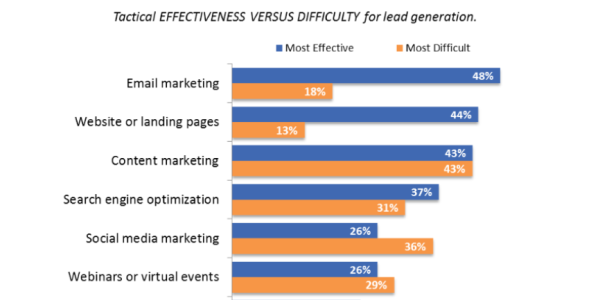- March 15, 2022
- Posted by: Christina Milian
- Category: blog

Email marketing is one of the most successful digital marketing tactics in 2022. Its strong return on investment demonstrates that even a tiny expenditure can dramatically increase a company’s sales.
“Email has an ability many channels don’t: creating valuable, personal touches – at scale.” – David Newman
Modern email marketing doesn’t always get the credit it deserves: some may still consider it “old school”, with newer digital marketing methods, like social media marketing, often taking center stage. However, email marketing can be an extremely effective method for acquiring new customers and retaining long-time customers when used to its full potential. According to Ascend2, over 48% of marketers feel that email marketing is the most effective approach for generating new customers.

Source: Ascend2
Do you have any doubts? Take a look at the numbers:
- The email has a 4 times larger organic reach than social media.
- Click-through rate of a segmented email campaign is 100.95% greater than that of non-segmented.
- Email returns $38 for every dollar invested, a 3,800% ROI, making one of the most effective solutions accessible.
- Marketers, who deploy specialized advertising, report revenue increases of up to 760%.
- 73% of businesses consider email to be a “great” marketing channel in terms of return on investment.
Key factors for finding New Customers with Email Marketing?
1. Craft an Impactful Email Subject Line
The subject of the message is the window of your email and, perhaps, also that of your company. It is, therefore, its formulation that makes the recipient want to read your content or not. If you send emails with cluttered or monotonous subject lines, the majority of your messages will end up unread in the trash and your prospect will be looking to get out of your mailing list as quickly as possible.
Hence the importance of using subject lines as short as possible: the reference length established for email marketing is between 40 – 50 characters or not more than six words. Of course, your subject should give an overview of the content of your email without saying too much so as to maintain the suspense.
This lack of space obliges you to go to the essential: avoid the superfluous, such as the word “newsletter”, a formula designating the recipient or a reminder of the sender. Current messaging systems already display this type of information. Instead, find a catchphrase that makes them want to know more. For the subject of your next email, feel free to spend as much time as on the text of the email.
After all, it’s the subject line that decides whether your recipients will give the rest of your text a chance. The headline alone should communicate the value of the newsletter and entice the recipient to open and read it. An unread email is not better than an unsent email.
2. Grab Attention with an Interesting Topic
What would you click on first: an Instagram post, a Facebook post, a message from a friend, a tweet from your current influencer, or a company email? It’s a jungle out there: the competition for a potential customer’s attention is fierce. Focusing on creating an attention-grabbing email is a crucial part of the engagement process.
According to a survey jointly conducted by Forrester Research and Shop.org, 85 per cent of US retailers take into account email marketing to be one of the most effective customer acquisition techniques, mainly for start-ups and SMBs. In fact, the average return on investment for email marketing is 122% for every dollar spent.
A/B testing lets you gauge which type of subject is right for your target audience. This feature allows you to send two different versions of the newsletter to a small percentage of your mailing list and ultimately choose the title that worked best for the rest of the recipients. Also, pay attention to the length. On many devices, we can see only the first few words. That’s why it’s better to choose a shorter topic of five to seven words.
3. Offer Content with High Added Value
At the end of 2021, there were 4.1B email users worldwide. Sending regular email campaigns meets the same requirements as other content strategies. It is a process that requires time and organization. This is why we recommend an editorial schedule in order to vary the themes dealt with.
In addition, emailing is a complex format since it feeds on other content formats. An email containing, for example, a video as well as a blog article and whose call-to-action at the end of the page invites the reader to register for training on the subject mentioned is a good campaign model with high added value.
“Content builds relationships. Relationships are built on trust. Trust drives revenue.” — Andrew Davis, Author & Keynote Speaker, Monumental Shift.
4. Personalize Your Content
Each of your potential customers is different and has different needs and other expectations. So, why send them all the same impersonal mass email? Use the personalization modules offered by professional emailing software to individualize your messages and send different products to your contacts according to criteria that you define – such as age, title or purchasing behavior. A tailored experience, according to Dynamic Yield, 71% of consumers, would affect their decision to open and read brand emails.

Source: Ascend2
“Personalization is not about first or last name. It’s about relevant content.” – Dan Jak.
5. Define The Frequency of Sending
Regularity is one of the most important criteria in emailing. The audience targeted by this type of content has, in fact, consented to receive messages by placing their trust in you. Although they are interested in what you offer, the reader does not want to be bombarded with too frequent messages. Multiple mailings after a long period without communicating are also to be avoided.
The ideal frequency of sending an email directly depends on the nature of your target. While some check their mailbox several times a day, in a professional context, and others only go there once or twice a week. The most important thing is to set a sending frequency and maintain it as much as possible. Your contacts should not feel harassed or forgotten.
Final Words
Email marketing is still one of the most effective marketing tools for attracting and growing your consumer base, even in this day and age of social media marketing. The most effective ways of email marketing that your prospective customers would love to have in their inboxes are outlined in this article. However, in order to increase your email marketing campaign and email conversions in a short period of time, you must create your email with the right tips.

